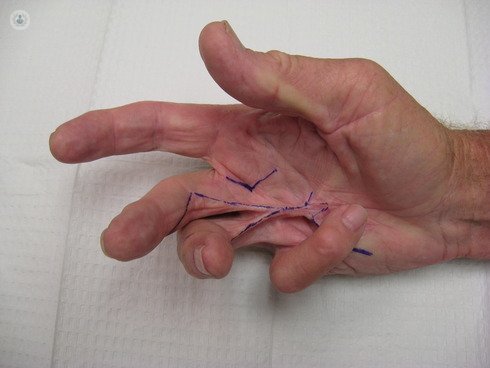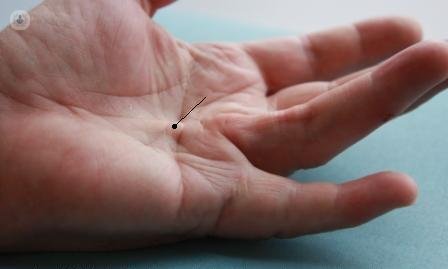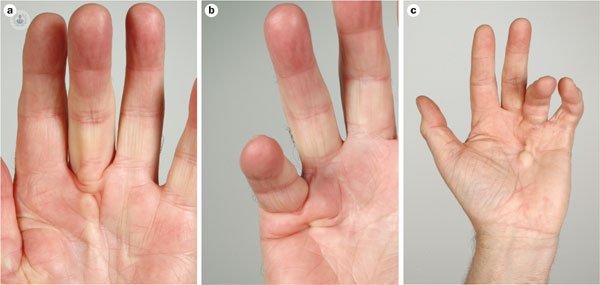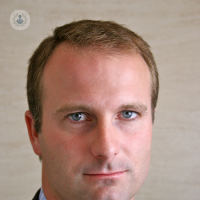Why do I have Dupuytren's contracture?
Written by:
The doctor. Galindo Martens is a recognized traumatologist with arthroscopic surgery and percutaneous surgery of the foot (bunion, claw toes, spur, neuroma of morton) and hand (carpal tunnel, Dupuytren, scaphoid). He has been trained both in Madrid and in other cities around the world such as Miami and Australia, and has participated in conferences and communications around the world, as well as publications and courses in his specialty. The following article explains what Dupuytren's disease is.
Dupuytren's disease is a chronic condition of the hand that causes the progressive and permanent flexion of some fingers (usually the ring finger followed by the little finger, heart and index finger) is affected towards the palm of the hand, restricting its function .
It is present in countries such as Spain (4%), the United Kingdom (6%) and Germany, (5%), and mainly affects men over 50; in women appears at more advanced ages and with less intensity. In general, it affects both hands, although it usually manifests first in one, especially in the right.
Its name is due to the surgeon Guillaume Dupuytren who described for the first time the signs of the disease in century XIX.
Causes of Dupuytren's disease

Dupuytren's disease is caused by the thickening and retraction of the membrane that forms the sheath of the flexor tendons of the fingers (palmar aponeurosis). Unlike the fingers in spring, this pathology does not affect the tendons but the fascia, that ends up involving the tendons impeding their normal mobility.
There is no apparent cause, but it occurs more frequently in people who perform certain manual tasks that require vibrating tools (pneumatic drills, etc.). Diabetes, antiepileptic drug use, smoking and alcoholism would favor its appearance.
In addition, there is a genetic predisposition, since Dupuytren's disease affects 50% of the members of the same family.
Symptoms of Dupuytren's disease
In Dupuytren's disease, tissues that lie below the skin tend to thicken and retract, resulting in the formation of small fibrous (nodules), hard and palpable balls in the palm of the hand.
Subsequently, appears under the skin a kind of cord formed by thickened tissue (retraction flange). Later, the involvement of the joints of the fingers causes their flexion.
The onset of the disease is usually painless. It can remain so for years, at which time the movements of the fingers are free and are little diminished. Further on, the mobility of the hand begins to worsen , especially to grasp objects, and there may be great difficulty in fully supporting the palm of the hand on a flat surface or to fully stretch the fingers. In some cases, even the fingers can not be separated.
In a more advanced state, the fingers are locked, and can not be extended.
Patients have difficulties in the normal development of their work. They have trouble putting on their shoes, shaking hands, combing, washing or makeup.
In the presence of one or more of the symptoms mentioned, and especially having some of the predisposing causes, it is advisable to consult the trauma doctor as soon as possible. The recovery is much more favorable as soon as the disease has been discovered and treated earlier.

Stages of Dupuytren's disease
- 1. First stage: the patient feels thickening in the skin of the palm of his hand, in which new dimples appear. It has bumps on its fingers, near its knuckles (Garrod's nodes). The palm of the hand has new fabric covering the knuckles, known as knuckle pads.
- 2. Middle stage: The patient may feel a firm, raised bump under the skin of the palm of his or her hand or finger, or may feel more than a protuberance. You may notice a rope of thickened tissue, firm in the palm of your hand or finger.
- 3. Advanced stage: one or more of the fingers are bent towards the palm of your hand, so that the palm is bent.
Treatment of Dupuytren's disease
The goal of treatment of Dupuytren's disease , which has greatly evolved over the past 10 years, is the recovery of the extension of the fingers without loss of flexion. It is usually effective in more than 80% of cases, although if there is blockage of the joint, the effectiveness is a little lower (70%).
Percutaneous surgery usually gets great results if Dupuytren's disease is treated from the start.
Dupuytren's Disease Surgeries
- Fasciotomy: with a special needle or blade to divide the strings in the palm of the hand or finger.
- Fasciectomy: With this surgery, some or all of the thickened tissue and strings are removed.
- Joint surgery: to release the joint.

After the surgery we recommend that the patient receive rehabilitative treatment , to decrease the symptoms, and to help the hand to function better. In this way, a Physiotherapy specialist will help you with hand exercises that aim to increase mobility of the hand and fingers.
Sometimes, along with Dupuytren's disease, thickened lumps of tissue may appear on other parts of the body. For example, if it appears on the feet, it could be plantar fibromatosis or Ledderhose disease. In men, bulges can form in the penis, in what is known as penile fibromatosis or Peyronie's disease.
In any case, the involvement of the hand by Dupuytren's palmar fibrosis is the most limiting of all these pathologies.
Advantages of minimally invasive surgery
Minimally invasive surgery allows both early and late treatment of Dupuytren's disease, which offers great advantages over conventional open surgery:
- The damage of the skin is less and, therefore, the fibrous sequelae are smaller.
- The risk of vascular injury and skin necrosis is minimal.
- Aesthetic damage is also much less.
- Recovery is much faster.
- The return to sports and work can be done in less time.
- If a new surgery is needed, this would be much easier, since there will not be extensive scarring on the hand.
- The likelihood of relapse seems to be the same as with classical open surgery procedures.
Thus, minimally invasive surgery is the most recommended option in most cases.




